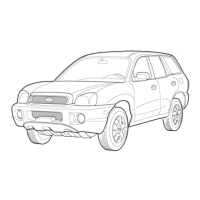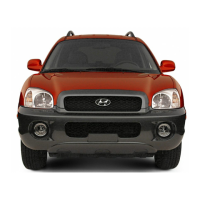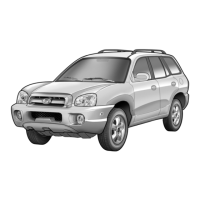Do you have a question about the Hyundai 2003 Santa Fe and is the answer not in the manual?
Explains the meaning of various warning and indicator lights on the instrument panel.
Details about the vehicle keys, including recording the key number and spare key usage.
Instructions on how to lock and unlock the vehicle's doors from inside and outside.
Information on proper seat belt usage, including front and rear seat belts and precautions.
Explains the SRS airbag system, its components, operation, and safety precautions.
Instructions on how to set, cancel, resume, and reset cruise control speeds.
Explains the operation of the climate control system, including vents and fan speed.
Pre-start checks for the vehicle to ensure it is ready for operation.
Step-by-step procedure for starting the engine under normal conditions.
Provides essential advice for safe braking and handling of the vehicle.
Explanation of the manual transmission shift pattern and operation.
Details on the automatic transmission, including shift points and selector lever positions.
Explains the function and operation of the ABS system and its behavior during braking.
Tips and precautions for driving safely in severe winter conditions like snow and ice.
Troubleshooting steps for when the engine fails to start or starts slowly.
Detailed procedure and safety warnings for jump-starting a vehicle's battery.
Instructions on how to safely change a flat tire on the vehicle.
Guidance on how to properly tow the vehicle to prevent damage.
Explains the importance of owner's cooperation in achieving long-term corrosion resistance.
Tips on preventing corrosion, focusing on keeping the car clean and free of corrosive materials.
Proper procedures for washing and waxing the vehicle to maintain its finish.
Instructions for cleaning the vinyl and leather upholstery of the vehicle's interior.
Outlines the required maintenance procedures to ensure vehicle longevity and warranty compliance.
Details the services required for optimal emission control and performance, with mileage/time intervals.
Lists items requiring more frequent service when the vehicle is used under severe driving conditions.
Provides detailed explanations for various scheduled maintenance tasks.
Identifies key components within the engine compartment for various engine types.
Instructions on how to check and add engine oil, including recommended oil types.
Step-by-step guide for changing the engine oil and filter, with safety warnings.
Guidance on how to check and maintain the vehicle's battery, including safety precautions.
Overview of the emission control system designed to meet regulatory requirements.
Explains the Exhaust Gas Recirculation system's function in reducing nitrogen oxides.
Information on the catalytic converter's function, operation, and safety precautions.
Explains where to find the VIN and its importance for registration and legal matters.
Details recommended tire inflation pressures for optimal performance and safety.
Provides the recommended interval for tire rotation and checks after rotation.
Lists the various limited warranties provided with a new Hyundai vehicle.
Instructions on how to report vehicle defects to NHTSA and Hyundai Motor America.
Provides key vehicle dimensions such as overall length, width, height, and wheelbase.
Details engine specifications including type, bore, stroke, displacement, and spark plugs.
Specifies recommended oils, fluids, and coolants for various vehicle components.
Explains the meaning of various warning and indicator lights on the instrument panel.
Details about the vehicle keys, including recording the key number and spare key usage.
Instructions on how to lock and unlock the vehicle's doors from inside and outside.
Information on proper seat belt usage, including front and rear seat belts and precautions.
Explains the SRS airbag system, its components, operation, and safety precautions.
Instructions on how to set, cancel, resume, and reset cruise control speeds.
Explains the operation of the climate control system, including vents and fan speed.
Pre-start checks for the vehicle to ensure it is ready for operation.
Step-by-step procedure for starting the engine under normal conditions.
Provides essential advice for safe braking and handling of the vehicle.
Explanation of the manual transmission shift pattern and operation.
Details on the automatic transmission, including shift points and selector lever positions.
Explains the function and operation of the ABS system and its behavior during braking.
Tips and precautions for driving safely in severe winter conditions like snow and ice.
Troubleshooting steps for when the engine fails to start or starts slowly.
Detailed procedure and safety warnings for jump-starting a vehicle's battery.
Instructions on how to safely change a flat tire on the vehicle.
Guidance on how to properly tow the vehicle to prevent damage.
Explains the importance of owner's cooperation in achieving long-term corrosion resistance.
Tips on preventing corrosion, focusing on keeping the car clean and free of corrosive materials.
Proper procedures for washing and waxing the vehicle to maintain its finish.
Instructions for cleaning the vinyl and leather upholstery of the vehicle's interior.
Outlines the required maintenance procedures to ensure vehicle longevity and warranty compliance.
Details the services required for optimal emission control and performance, with mileage/time intervals.
Lists items requiring more frequent service when the vehicle is used under severe driving conditions.
Provides detailed explanations for various scheduled maintenance tasks.
Identifies key components within the engine compartment for various engine types.
Instructions on how to check and add engine oil, including recommended oil types.
Step-by-step guide for changing the engine oil and filter, with safety warnings.
Guidance on how to check and maintain the vehicle's battery, including safety precautions.
Overview of the emission control system designed to meet regulatory requirements.
Explains the Exhaust Gas Recirculation system's function in reducing nitrogen oxides.
Information on the catalytic converter's function, operation, and safety precautions.
Explains where to find the VIN and its importance for registration and legal matters.
Details recommended tire inflation pressures for optimal performance and safety.
Provides the recommended interval for tire rotation and checks after rotation.
Lists the various limited warranties provided with a new Hyundai vehicle.
Instructions on how to report vehicle defects to NHTSA and Hyundai Motor America.
Provides key vehicle dimensions such as overall length, width, height, and wheelbase.
Details engine specifications including type, bore, stroke, displacement, and spark plugs.
Specifies recommended oils, fluids, and coolants for various vehicle components.
| Brand | Hyundai |
|---|---|
| Model | 2003 Santa Fe |
| Category | Automobile |
| Language | English |











